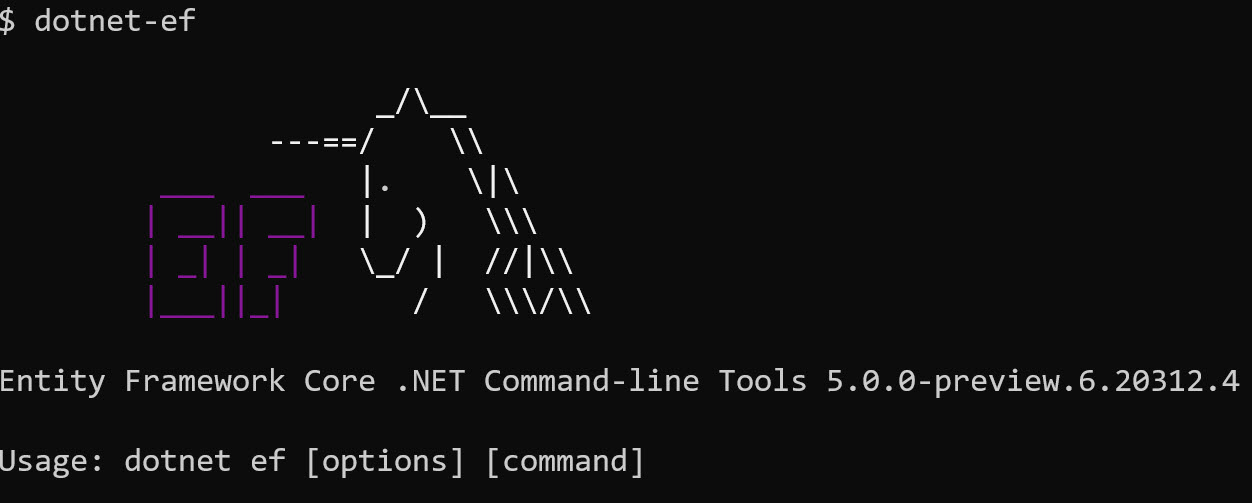Today, the Entity Framework Core team announces the sixth preview release of EF Core 5.0. This release includes split queries for related collections, a new “index” attribute, improved exceptions related to query translations, IP address mapping, exposing transaction id for correlation, and much more.
Prerequisites
EF Core 5.0 will not run on .NET Standard 2.0 platforms, including .NET Framework.
The previews of EF Core 5.0 require .NET Standard 2.1. This means that EF Core 5.0 will run on .NET Core 3.1 and does not require .NET 5. To summarize: EF Core 5.0 runs on platforms that support .NET Standard 2.1.
The plan is to maintain .NET Standard 2.1 compatibility through the final release.
Be a part of .NET 5
The .NET documentation team is reorganizing .NET content to better match the workloads you build with .NET. This includes a new .NET Data landing page that will link out to data-related topics ranging from EF Core to APIs, Big Data, and Machine learning. The planning and execution will be done completely in the open on GitHub. This is your opportunity to help shape the hierarchy and content to best fit your needs as a .NET developer. We look forward to your contributions!
How to get EF Core 5.0 previews
EF Core is distributed exclusively as a set of NuGet packages. For example, to add the SQL Server provider to your project, you can use the following command using the dotnet tool:
dotnet add package Microsoft.EntityFrameworkCore.SqlServer --version 5.0.0-preview.6.20312.4
This following table links to the preview 6 versions of the EF Core packages and describes what they are used for.
| Package | Purpose |
|---|---|
| Microsoft.EntityFrameworkCore | The main EF Core package that is independent of specific database providers |
| Microsoft.EntityFrameworkCore.SqlServer | Database provider for Microsoft SQL Server and SQL Azure |
| Microsoft.EntityFrameworkCore.SqlServer.NetTopologySuite | SQL Server support for spatial types |
| Microsoft.EntityFrameworkCore.Sqlite | Database provider for SQLite that includes the native binary for the database engine |
| Microsoft.EntityFrameworkCore.Sqlite.Core | Database provider for SQLite without a packaged native binary |
| Microsoft.EntityFrameworkCore.Sqlite.NetTopologySuite | SQLite support for spatial types |
| Microsoft.EntityFrameworkCore.Cosmos | Database provider for Azure Cosmos DB |
| Microsoft.EntityFrameworkCore.InMemory | The in-memory database provider |
| Microsoft.EntityFrameworkCore.Tools | EF Core PowerShell commands for the Visual Studio Package Manager Console; use this to integrate tools like scaffolding and migrations with Visual Studio |
| Microsoft.EntityFrameworkCore.Design | Shared design-time components for EF Core tools |
| Microsoft.EntityFrameworkCore.Proxies | Lazy-loading and change-tracking proxies |
| Microsoft.EntityFrameworkCore.Abstractions | Decoupled EF Core abstractions; use this for features like extended data annotations defined by EF Core |
| Microsoft.EntityFrameworkCore.Relational | Shared EF Core components for relational database providers |
| Microsoft.EntityFrameworkCore.Analyzers | C# analyzers for EF Core |
We also published the 5.0 preview 6 release of the Microsoft.Data.Sqlite.Core provider for ADO.NET.
Installing the EF Core Command Line Interface (CLI)
As with EF Core 3.0 and 3.1, the EF Core CLI is no longer included in the .NET Core SDK. Before you can execute EF Core migration or scaffolding commands, you’ll have to install this package as either a global or local tool.

To install the preview tool globally, first uninstall any existing version with:
dotnet tool uninstall --global dotnet-ef
Then install with:
dotnet tool install --global dotnet-ef --version 5.0.0-preview.6.20312.4
It’s possible to use this new version of the EF Core CLI with projects that use older versions of the EF Core runtime.
What’s New in EF Core 5 Preview 6
We maintain documentation covering new features introduced into each preview.
Some of the highlights from preview 6 are called out below. This preview also includes several bug fixes.
Split queries for related collections
Starting with EF Core 3.0, EF Core always generates a single SQL query for each LINQ query. This ensures consistency of the data returned within the constraints of the transaction mode in use. However, this can become very slow when the query uses Include or a projection to bring back multiple related collections.
EF Core 5.0 now allows a single LINQ query including related collections to be split into multiple SQL queries. This can significantly improve performance, but can result in inconsistency in the results returned if the data changes between the two queries. Transactions can be used to mitigate this, at least within the constraints of the transaction mode in use.
Split queries with Include
For example, consider a query that pulls in two levels of related collections using Include:
var artists = context.Artists
.Include(e => e.Albums).ThenInclude(e => e.Tags)
.ToList();
By default, EF Core will generate the following SQL when using the SQLite provider:
SELECT "a"."Id", "a"."Name", "t0"."Id", "t0"."ArtistId", "t0"."Title", "t0"."Id0", "t0"."AlbumId", "t0"."Name"
FROM "Artists" AS "a"
LEFT JOIN (
SELECT "a0"."Id", "a0"."ArtistId", "a0"."Title", "t"."Id" AS "Id0", "t"."AlbumId", "t"."Name"
FROM "Album" AS "a0"
LEFT JOIN "Tag" AS "t" ON "a0"."Id" = "t"."AlbumId"
) AS "t0" ON "a"."Id" = "t0"."ArtistId"
ORDER BY "a"."Id", "t0"."Id", "t0"."Id0"
The new AsSplitQuery API can be used to change this behavior. For example:
var artists = context.Artists
.AsSplitQuery()
.Include(e => e.Albums).ThenInclude(e => e.Tags)
.ToList();
AsSplitQuery is available for all relational database providers and can be used anywhere in the query, just like AsNoTracking. EF Core will now generate the following three SQL queries:
SELECT "a"."Id", "a"."Name"
FROM "Artists" AS "a"
ORDER BY "a"."Id"
SELECT "a0"."Id", "a0"."ArtistId", "a0"."Title", "a"."Id"
FROM "Artists" AS "a"
INNER JOIN "Album" AS "a0" ON "a"."Id" = "a0"."ArtistId"
ORDER BY "a"."Id", "a0"."Id"
SELECT "t"."Id", "t"."AlbumId", "t"."Name", "a"."Id", "a0"."Id"
FROM "Artists" AS "a"
INNER JOIN "Album" AS "a0" ON "a"."Id" = "a0"."ArtistId"
INNER JOIN "Tag" AS "t" ON "a0"."Id" = "t"."AlbumId"
ORDER BY "a"."Id", "a0"."Id"
All operations on the query root are supported. This includes OrderBy/Skip/Take, Join operations, FirstOrDefault and similar single result selecting operations.
Note that filtered Includes with OrderBy/Skip/Take are not supported in preview 6, but are available in the daily builds and will be included in preview 7.
Split queries with collection projections
AsSplitQuery can also be used when collections are loaded in projections. For example:
context.Artists
.AsSplitQuery()
.Select(e => new
{
Artist = e,
Albums = e.Albums,
}).ToList();
This LINQ query generates the following two SQL queries when using the SQLite provider:
SELECT "a"."Id", "a"."Name"
FROM "Artists" AS "a"
ORDER BY "a"."Id"
SELECT "a0"."Id", "a0"."ArtistId", "a0"."Title", "a"."Id"
FROM "Artists" AS "a"
INNER JOIN "Album" AS "a0" ON "a"."Id" = "a0"."ArtistId"
ORDER BY "a"."Id"
Note that only materialization of the collection is supported. Any composition after e.Albums in above case won’t result in a split query. Improvements in this area are tracked by #21234.
IndexAttribute
The new IndexAttribute can be placed on an entity type to specify an index for a single column. For example:
[Index(nameof(FullName), IsUnique = true)]
public class User
{
public int Id { get; set; }
[MaxLength(128)]
public string FullName { get; set; }
}
For SQL Server, Migrations will then generate the following SQL:
CREATE UNIQUE INDEX [IX_Users_FullName]
ON [Users] ([FullName])
WHERE [FullName] IS NOT NULL;
IndexAttribute can also be used to specify an index spanning multiple columns. For example:
[Index(nameof(FirstName), nameof(LastName), IsUnique = true)]
public class User
{
public int Id { get; set; }
[MaxLength(64)]
public string FirstName { get; set; }
[MaxLength(64)]
public string LastName { get; set; }
}
For SQL Server, this results in:
CREATE UNIQUE INDEX [IX_Users_FirstName_LastName]
ON [Users] ([FirstName], [LastName])
WHERE [FirstName] IS NOT NULL AND [LastName] IS NOT NULL;
Documentation is tracked by issue #2407.
Improved query translation exceptions
We are continuing to improve the exception messages generated when query translation fails. For example, this query uses the unmapped property IsSigned:
var artists = context.Artists.Where(e => e.IsSigned).ToList();
EF Core will throw the following exception indicating that translation failed because IsSigned is not mapped:
Unhandled exception. System.InvalidOperationException: The LINQ expression ‘DbSet() .Where(a => a.IsSigned)’ could not be translated. Additional information: Translation of member ‘IsSigned’ on entity type ‘Artist’ failed. Possibly the specified member is not mapped. Either rewrite the query in a form that can be translated, or switch to client evaluation explicitly by inserting a call to either AsEnumerable(), AsAsyncEnumerable(), ToList(), or ToListAsync(). See https://go.microsoft.com/fwlink/?linkid=2101038 for more information.
Similarly, better exception messages are now generated when attempting to translate string comparisons with culture-dependent semantics. For example, this query attempts to use StringComparison.CurrentCulture:
var artists = context.Artists
.Where(e => e.Name.Equals("The Unicorns", StringComparison.CurrentCulture))
.ToList();
EF Core will now throw the following exception:
Unhandled exception. System.InvalidOperationException: The LINQ expression ‘DbSet() .Where(a => a.Name.Equals( value: “The Unicorns”, comparisonType: CurrentCulture))’ could not be translated. Additional information: Translation of ‘string.Equals’ method which takes ‘StringComparison’ argument is not supported. See https://go.microsoft.com/fwlink/?linkid=2129535 for more information. Either rewrite the query in a form that can be translated, or switch to client evaluation explicitly by inserting a call to either AsEnumerable(), AsAsyncEnumerable(), ToList(), or ToListAsync(). See https://go.microsoft.com/fwlink/?linkid=2101038 for more information.
Specify transaction ID
This feature was contributed from the community by @Marusyk. Many thanks for the contribution!
EF Core exposes a transaction ID for correlation of transactions across calls. This is typically set by EF Core when a transaction is started. If the application starts the transaction instead, then this feature allows the application to explicitly set the transaction ID so it is correlated correctly everywhere it is used. For example:
using (context.Database.UseTransaction(myTransaction, myId))
{
...
}
IPAddress mapping
This feature was contributed from the community by @ralmsdeveloper. Many thanks for the contribution!
The standard .NET IPAddress class is now automatically mapped to a string column for databases that do not already have native support. For example, consider mapping this entity type:
public class Host
{
public int Id { get; set; }
public IPAddress Address { get; set; }
}
On SQL Server, this will result in Migrations creating the following table:
CREATE TABLE [Host] (
[Id] int NOT NULL,
[Address] nvarchar(45) NULL,
CONSTRAINT [PK_Host] PRIMARY KEY ([Id]));
Entities can then be added in the normal way:
context.AddRange(
new Host { Address = IPAddress.Parse("127.0.0.1")},
new Host { Address = IPAddress.Parse("0000:0000:0000:0000:0000:0000:0000:0001")});
And the resulting SQL will insert the normalized IPv4 or IPv6 address:
Executed DbCommand (14ms) [Parameters=[@p0='1', @p1='127.0.0.1' (Size = 45), @p2='2', @p3='::1' (Size = 45)], CommandType='Text', CommandTimeout='30']
SET NOCOUNT ON;
INSERT INTO [Host] ([Id], [Address])
VALUES (@p0, @p1), (@p2, @p3);
Exclude OnConfiguring when scaffolding
When a DbContext is scaffolded from an existing database, EF Core by default creates an OnConfiguring overload with a connection string so that the context is immediately usable. However, this is not useful if you already have a partial class with OnConfiguring, or if you are configuring the context some other way.
To address this, the scaffolding commands can now be instructed to ommit generation of OnConfiguring. For example:
dotnet ef dbcontext scaffold "Data Source=(localdb)\MSSQLLocalDB;Initial Catalog=Chinook" Microsoft.EntityFrameworkCore.SqlServer --no-onconfiguring
Or in the Package Manager Console:
Scaffold-DbContext 'Data Source=(localdb)\MSSQLLocalDB;Initial Catalog=Chinook' Microsoft.EntityFrameworkCore.SqlServer -NoOnConfiguring
Note that we recommend using a named connection string and secure storage like User Secrets.
Translations for FirstOrDefault on strings
This feature was contributed from the community by @dvoreckyaa. Many thanks for the contribution!
FirstOrDefault and similar operators for characters in strings are now translated. For example, this LINQ query:
context.Customers.Where(c => c.ContactName.FirstOrDefault() == 'A').ToList();
Will be translated to the following SQL when using SQL Server:
SELECT [c].[Id], [c].[ContactName]
FROM [Customer] AS [c]
WHERE SUBSTRING([c].[ContactName], 1, 1) = N'A'
Simplify case blocks
EF Core now generates better queries with CASE blocks. For example, this LINQ query:
context.Weapons
.OrderBy(w => w.Name.CompareTo("Marcus' Lancer") == 0)
.ThenBy(w => w.Id)
Was on SQL Server formally translated to:
SELECT [w].[Id], [w].[AmmunitionType], [w].[IsAutomatic], [w].[Name], [w].[OwnerFullName], [w].[SynergyWithId]
FROM [Weapons] AS [w]
ORDER BY CASE
WHEN (CASE
WHEN [w].[Name] = N'Marcus'' Lancer' THEN 0
WHEN [w].[Name] > N'Marcus'' Lancer' THEN 1
WHEN [w].[Name] < N'Marcus'' Lancer' THEN -1
END = 0) AND CASE
WHEN [w].[Name] = N'Marcus'' Lancer' THEN 0
WHEN [w].[Name] > N'Marcus'' Lancer' THEN 1
WHEN [w].[Name] < N'Marcus'' Lancer' THEN -1
END IS NOT NULL THEN CAST(1 AS bit)
ELSE CAST(0 AS bit)
END, [w].[Id]");
But is now translated to:
SELECT [w].[Id], [w].[AmmunitionType], [w].[IsAutomatic], [w].[Name], [w].[OwnerFullName], [w].[SynergyWithId]
FROM [Weapons] AS [w]
ORDER BY CASE
WHEN ([w].[Name] = N'Marcus'' Lancer') AND [w].[Name] IS NOT NULL THEN CAST(1 AS bit)
ELSE CAST(0 AS bit)
END, [w].[Id]");
Daily builds
EF Core previews are aligned with .NET 5 previews. These previews tend to lag behind the latest work on EF Core. Consider using the daily builds instead to get the most up-to-date EF Core features and bug fixes.
As with the previews, the daily builds do not require .NET 5; they can be used with GA/RTM release of .NET Core 3.1.
The EF Core Community Standup
The EF Core team is now live streaming every other Wednesday at 10am Pacific Time, 1pm Eastern Time, or 17:00 UTC. Join the stream to ask questions about the EF Core topic of your choice, including the latest preview release.
- Visit the .NET Community Standup page to preview upcoming shows and view recordings from past shows
- Suggest a guest or project, including your own by posting to the linked discussion
- You can also request an EF Core demo
Documentation and feedback
The starting point for all EF Core documentation is docs.microsoft.com/ef/.
Please file issues found and any other feedback on the dotnet/efcore GitHub repo.
Helpful Short Links
The following short links are provided for easy reference and access.
Main documentation: https://aka.ms/efdocs
Issues and feature requests for EF Core: https://aka.ms/efcorefeedback
Entity Framework Roadmap: https://aka.ms/efroadmap
What’s new in EF Core 5.x? https://aka.ms/efcore5
Thank you from the team
A big thank you from the EF team to everyone who has used EF over the years!
 Arthur Vickers
Arthur Vickers |
 Andriy Svyryd
Andriy Svyryd |
 Brice Lambson
Brice Lambson |
 Jeremy Likness
Jeremy Likness |
 lajones
lajones |
 Maurycy Markowski
Maurycy Markowski |
 Shay Rojansky
Shay Rojansky |
 Smit Patel
Smit Patel |
Thank you to our contributors!
A big thank you to the following community members who have already contributed code or documentation to the EF Core 5 release! (List is in chronological order of first contribution to EF Core 5).

 aevitas
aevitas Alaa Masoud
Alaa Masoud Aleksandar Manukov
Aleksandar Manukov Amr Badawy
Amr Badawy Anthony Monterrosa
Anthony Monterrosa Ben Brandt
Ben Brandt Ben McCallum
Ben McCallum Clarence Cai
Clarence Cai Christophe Gijbels
Christophe Gijbels Jiri Cincura
Jiri Cincura Vincent Costel
Vincent Costel Dmitry Shuvaev
Dmitry Shuvaev Eric St-Georges
Eric St-Georges Erik Ejlskov Jensen
Erik Ejlskov Jensen Christopher Davis
Christopher Davis Ivaylo Kenov
Ivaylo Kenov Jacob Foshee
Jacob Foshee Jeremy Zagorski
Jeremy Zagorski Jacob Viau
Jacob Viau Max K.
Max K. lohoris-crane
lohoris-crane Loïc Sharma
Loïc Sharma lokalmatador
lokalmatador Marius Gundersen
Marius Gundersen Roman Marusyk
Roman Marusyk Matthias Lischka
Matthias Lischka MaxG117
MaxG117 MHDuke
MHDuke Mike Surcouf
Mike Surcouf Neil Bostrom
Neil Bostrom Nícolas Michels
Nícolas Michels Obi Oberoi
Obi Oberoi Josh Studt
Josh Studt Ozan Topal
Ozan Topal Paul Middleton
Paul Middleton Raj
Raj Peter Huang
Peter Huang Rafael Almeida Santos
Rafael Almeida Santos Patrik Husfloen
Patrik Husfloen Richard Marskell
Richard Marskell sguitardude
sguitardude Sam Hobbs
Sam Hobbs Sven
Sven Vlad
Vlad vslee
vslee liweihan
liweihan Youssef Victor
Youssef Victor 1iveowl
1iveowl Thomas Levesque
Thomas Levesque Aleksander Kovač
Aleksander Kovač Leonid Tsarev
Leonid Tsarev Konstantin Triger
Konstantin Triger Ivan Maximov
Ivan Maximov Dzmitry Lahoda
Dzmitry Lahoda Bruno Logerfo
Bruno Logerfo Josh Withee
Josh Withee Frans Bouma
Frans Bouma Matthew Lieder
Matthew Lieder Paulo Morgado
Paulo Morgado Mickaël Derriey
Mickaël Derriey Laurence King
Laurence King Oskar Josefsson
Oskar Josefsson bdebaere
bdebaere Bhargavi Annadevara
Bhargavi Annadevara Alexander Täschner
Alexander Täschner Jesse Hufstetler
Jesse Hufstetler Ivar Løvlie
Ivar Løvlie cucoreanu
cucoreanu Kirk Larkin
Kirk Larkin Svyatoslav Danyliv
Svyatoslav Danyliv Toni Wenzel
Toni Wenzel manvydasu
manvydasu Thomas Ryan
Thomas Ryan Aaron Gunther
Aaron Gunther
Interesting stuff, so sorry to nitpick, but where you say
Was on SQL Server formally translated to: above should say ‘formerly’
Some query execution speed tests ? SQL, Oracle, EF vs Ado.NET ?
When will EFCore Support to map a sql query as a "View" like block ,
forexample :
<code>
The split queries API seems extremely confusing and potentially misguiding.
When you say 'and can be used anywhere in the query', does this mean it has different semantics if placed at different points in the query?
This also seems like unnecessary leakage of abstraction of how the query is executed. If there are performance/correctness trade-offs for these perhaps the API should be called .SetExecutionMode(QueryMode.Performance) VS .SetExecutionMode(QueryMode.DataIntegrity) – with the documentation of each mode outlining what differences COULD happen in one VS the other.
The way it is currently defined, it's confusing as to what happens if a query doesn't have multiple variants...
Thanks for your feedback! I agree there is a lot to consider. The team is working on comprehensive documentation that you can follow by tracking this PR (#2486).
There are a few ways to address additional concerns you may have. For discussion, I encourage you to open a topic at this link where the team is active engaged. If there is a specific issue you are experiencing, please file one here so we can track and address it.
Regards, Jeremy
Regarding the split queries, you wrote “transactions can be used to mitigate this”. It’s not clear if EF core by default uses a transaction for a single query or not.
This should describe the behavior. Please let us know if it doesn’t: EF Core Transactions.
AFAIK, and maybe I’m wrong, no explicit transaction is created for running a query, but only when saving changes. Is this right?
Correct.
Thanks!
you guys are amazing would love to see focus on this tho:
https://github.com/dotnet/efcore/issues/11314#issuecomment-628218015
Well done.